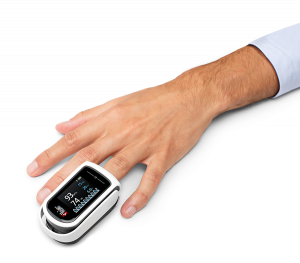Commercial Pulse Oximeters vs. the Apple Watch
As the pandemic raged around the world, blood oxygen measurements (SpO2) have been helpful indications of whether hospitalization is needed for individuals. However, SpO2 has been used as a vital indicator for a long time and for managing lung problems and other ailments. The most common device for this purpose is a pulse oximeter.

Pulse Oximeter Types
There are 2 types of pulse oximeters in the market – ones that are FDA reviewed and available under prescription, and others that are sold over the counter as wellness devices. Prescription pulse oximeters are available but are found in hospitals and offices rather than households. However, with costs ranging from $15 to $40 depending on model and rating, over-the-counter pulse oximeters are readily accessible and not too costly. The measurement from these devices is an estimation rather than an exact measurement.
Multiple wearable companies have come out with blood oxygen measurement capabilities on their devices, one of the most popular being the Apple Watch. This feature is built into watches Series 6 and higher. While there’s no doubt that having a SpO2 measurement on the Apple Watch is helpful, how accurate is it?

A study from the University of Sao Paulo published in Scientific Report took SpO2 data of 100 patients with pulmonary issues on both the common fingertip pulse oximeter and a Series 6 Apple Watch. The results showed a fairly strong positive correlation between the watch and the fingertip pulse oximeters, as well as statistical insignificance on variations in skin color, wrist size, etc. It is understood that the Apple Watch does display slightly higher SpO2 measurements than the pulse oximeter, defined as around 2-3% more.
Doctors do believe that taking SpO2 measurements from the wrist as compared to a fingertip would yield less accurate results; usually, the measurements may be affected by the tightness of the wristband or watch location. In that regard, commercial pulse oximeters are an easier way to guarantee more accurate results, as it’s fairly difficult to take the measurement incorrectly.
The Conclusion
Overall, which device comes out on top? While there is no doubt that fingertip SpO2 measurements are accurate, having a regular measurement done by an Apple Watch is invaluable in the convenience that it provides. It’s quite easy to slip on a fingertip SpO2 device once an Apple Watch tells you that the reading has dipped lower than the historical trend and a more accurate measurement is needed.
Further Reading

No comment yet, add your voice below!